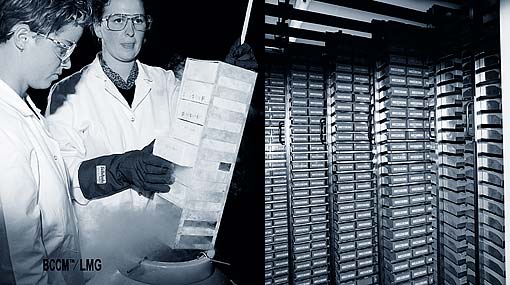
Edition 12 - November, 2002
 Edition 12 - November, 2002 |
The security of micro-organisms distributed by culture collections |
Is it easy to obtain anthrax or another organism capable of causing substantial harm to humans, animals or environments from a culture collection for use as a biological weapon? This question is being asked ever more frequently of late. The Biological and Toxin Weapons Convention (BWTC) (1), which entered into force in 1975, prohibits the deliberate use of a disease agent as a weapon against humans, animals and plants. By December 2001, 144 states had ratified this convention and 18 others had signed it, even a number of countries that are suspected of supporting international terrorism.
 Safe storage and distribution of microbial strains have always been of major concern for culture collections. |
Agents called "dual-use goods" are goods and technology developed
for civilian uses that may also be used for military applications or to produce
weapons, including biological weapons.
In 1985 after the Iran-Iraq war, the "Australia Group" was founded
to prevent the use and distribution of chemicals or biological weapons. At present,
the members of this group – 33 countries and the European Commission –
have drawn up a very specific list of biological agents that affect human, animals
and plants (bacteria, fungi, viruses) as well as toxins, genetic elements and
genetically modified organisms that are subject to export controls (2).
In 1994, the European Community issued Council Regulation 3381/94, which was
amended in 2000 by EC 1334/2000 and which defines community regulations for
the control of exports of dual-use items and technology outside the European
Community (3). For biological agents, the annex on dual-use items refers to
the list adopted by the Australia Group (2). This European regulation was rapidly
implemented in the EC countries – Belgium
ratified it in October 2000 (4) – before the anthrax events in USA. An
export licence is required for each transfer of biological material on the Australian
list.
All the official culture collections are members of the World Federation for
Culture Collections (WFCC). For the WFCC, which published guidelines for the
Establishment and Operation of Collections of Microorganisms (5), these security
matters are a very important issue.
The WFCC member collections strictly follow all the international regulations
on distribution and security. Even for organisms not on the dual-use goods list,
it is the collection’s duty to refuse to send organisms to customers who
are suspected of making illegitimate use of them. For organisms of Biosafety
Level 3, the collection must receive official written guarantees that the recipient
owns all the containment facilities required to handle them.
However, it should be stressed that most of the biological material is exchanged
outside culture collections by scientists from microbiological laboratories
who are not always aware of the regulations, so one of the missions of the collections
is to provide information about these issues.
Contact
Françoise Symoens
BCCM/IHEM Culture Collection
Tel.: +32 (0)2 642 56 30
Fax: +32 (0)2 642 55 19
E-mail: bccm.ihem@iph.fgov.be
Home |
Contents Edition 12 - November, 2002 |
Next Article Edition 12 - November, 2002 |